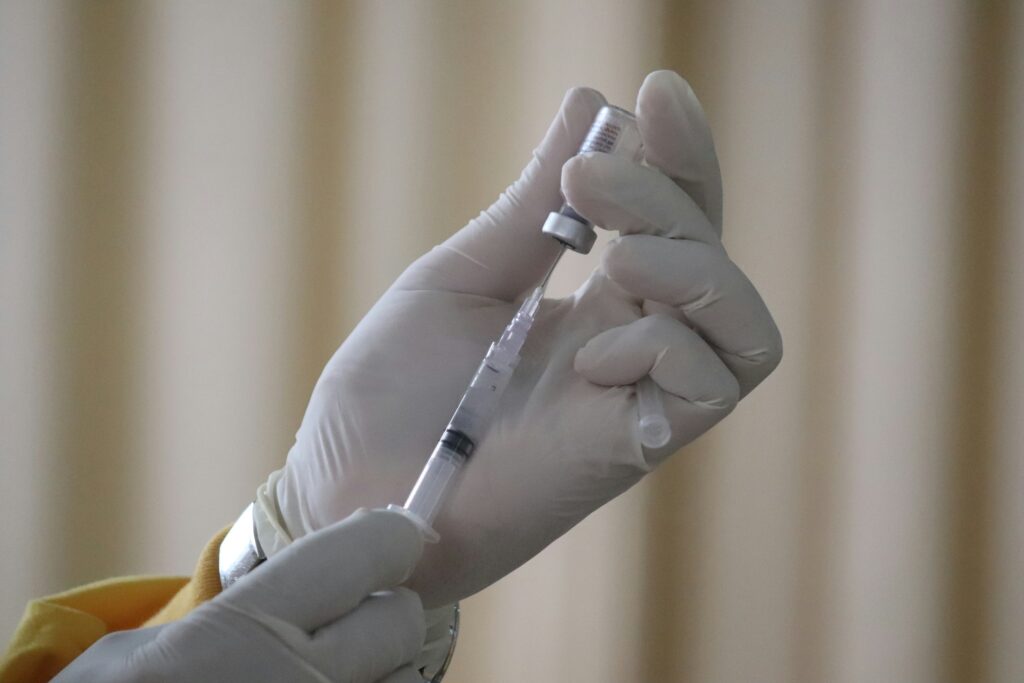News Team member Alexa Morales describes the need for new prenatal nutrition guidance to include fiber, as it promotes stronger microbiomes and better health outcomes in mothers and their babies.
Beyond COVID: mRNA Technology’s Leap into Cancer Treatment
Exploring the groundbreaking shift of mRNA vaccines from pandemic heroes to potential cancer cure pioneers.
By Ellie Purinton
In October of 2023, Katalin Karikó and Drew Weissman won the Nobel Prize in Medicine for their work developing mRNA vaccines for protection against COVID-19. While many people may not know these scientists by name, individuals from all over the globe are familiar with mRNA COVID-19 vaccines. As of March 2023, about 72% of the population worldwide had received a dose of the vaccine. But what many do not know is that this technology did not begin with the COVID-19 virus. The mRNA technology that has now helped millions across the globe had already been in development for cancer treatment for decades by the time the pandemic began. With the globe now easing back into pre-pandemic normalcy, research and development of mRNA cancer treatments have skyrocketed into a new era of vaccines and immunotherapy, as the journals Nature, Frontiers, and Viruses have all described.
The numerous ongoing trials of mRNA cancer therapeutics are stirring excitement not only in the world of oncology, but also in the general population. A clinical trial of a personalized mRNA vaccine for melanoma, developed by Merck and Moderna, has had news sources from USA Today to Time Magazine abuzz in recent months (see also the Smithsonian Magazine, Politico, and Bloomberg). Despite the promising data from this trial and others, the problem of patient access must be addressed as this technology advances, to ensure that this treatment is available and affordable for all. The world is significantly closer to a cure for cancer than it was decades ago, but there remain many challenges to overcome before effective cancer treatments are available for all patients globally.
The mRNA vaccine treatment developments for cancer are monumental. “I see this as a tremendous opportunity to have a major impact on cancer treatment,” says Jeffrey Weber, the principal investigator of the Phase 2 Study from Merck and Moderna. “I’m pretty optimistic. And I’m a skeptic and a pessimist by nature. So, I’m pretty impressed by the data.”

The first mRNA against cancer
The Merck/Moderna melanoma trial, also called the Keynote 942 trial, is making waves for its potential to be the first FDA-approved mRNA cancer treatment. In the 157-patient Phase 2 clinical trial, the vaccine reduced the risk of melanoma reoccurrence or death by 44%. While most people think of a vaccine as preventative, like the COVID-19 vaccine, this vaccine is therapeutic, meaning it addresses the already existing condition of cancer. This trial in particular uses the vaccine as an adjuvant therapy, meaning it treats melanoma in patients who have already been treated with a primary treatment. Investigators chose melanoma as a target because, In addition to being one of the most common cancers in the U.S., it is very immunologically active, meaning the immune system can be harnessed through a vaccine to attack the cancer.
One reason for the efficacy success of this vaccine is how it targets tumors. This trial marked the first randomized trial to show the potential benefit of targeting proteins called neoantigens that are present in tumors, an approach not used in failed cancer vaccines in previous years. Neoantigens are unique proteins that are generated from mutations in tumors. These proteins are only present in tumor cells, not in normal cells, so they make for the perfect target because normal cells are not at risk. The vaccine is programmed to recognize these neoantigens, prompting the immune system to mount a response against them and the tumor.
As exciting as this approach is, there is a catch. Neoantigens are not just unique to tumor cells; they are unique to each person. This means that in the Merck/Moderna trial, the vaccines must be personalized for each patient. For each patient, a small tumor sample is sent to a central facility. At this facility, the genetic components of the tumor are analyzed and compared to the patient’s normal DNA. A computer program determines which neoantigens to target in the tumor, and then the RNA encoded by the algorithm is made into a vaccine. This process takes about six weeks, which is part of the reason why Moderna has currently developed the vaccine as an adjuvant therapy; in individuals with aggressive cancer, six weeks may be too long.
The vaccine has another Achille’s heel, one that was revealed during the COVID-19 pandemic: the fragility of mRNA itself. Because mRNA is such a fragile molecule, mRNA vaccines need to be stored in extremely low temperatures, down to negative 70- or negative 80 degrees Fahrenheit. For distribution, this requires something called a cold chain, a supply chain that maintains a temperature low enough for the vaccine to remain viable. This means that hospitals and other treatment facilities must possess special, ultra-cold freezers, or at least have access to dry ice for temporary storage. While many of the difficulties involving the cold chain were improved upon during the pandemic, the temperature requirement remains a challenge for rural and low-income areas.
Roadblocks to universal access
In an area such as cancer with already existing disparities in care, the personalized aspect of this vaccine and the cold chain requirement raises important questions about who will have access to this potentially groundbreaking treatment. “In the early days, this would be mostly done in academic centers,” Weber says. “But the sending out of tumor specimens is routine. The sequencing is routine, and it is a 10-year-old technology. It’s not rocket science. And I wouldn’t see any impediments to this being done anywhere in the U.S., the EU, Canada, Asia, Australia, et cetera, where melanoma is common.”
“The actual production of the vaccine is relatively cheap,” says Ryan Sullivan, a physician investigator at the Massachusetts General Research Institute, who also worked on the development of the Merck/Moderna vaccine. “The hard part and the expensive part is the personalization. All the information that goes into the vaccine costs money. Access will be a problem, but access is a problem for every cancer drug we have.”
Access is indeed a problem for cancer drugs and not an insignificant one. A 2019 survey conducted by the American Society of Clinical Oncology found that nearly a third of family members of loved ones of those with cancer were very concerned about treatment affordability. This is not surprising, given that many cancer drugs cost thousands per month. Ipilimumab, for example, an immunotherapy drug for melanoma, cost $39,947 per month in 2014, a price that makes the treatment inaccessible for many.

Cancer drug access is a systematic problem, one that is not specific to mRNA cancer vaccines. Given that the potential cost of the treatment is not unique to mRNA vaccines, the question remains of whether access is a problem that requires immediate attention. “The real question that the field grapples with is, first can we do what we think we can do? And then, does what we’re doing work for patients? And then we definitely start thinking about the financial implications of it,” says Sullivan.
One way that the financial burden of mRNA cancer vaccines can be reduced is by creating general vaccines, instead of personalized ones that target neoantigens. This is an approach being studied by researchers such as Norbert Pardi, an assistant professor at the University of Pennsylvania who has worked closely with Nobel Prize winners Weissman and Karikó. Pardi has tested three different mRNA platforms in the therapeutic setting. Each of these approaches wasere effective and will be proceeding to clinical trials to evaluate how they work in humans. “Many people believe that [personalized vaccines] will be the future because then every single patient could get a specific treatment,” says Pardi. “The only potential drawback that we need to mention is that it’s going to be very expensive, so every single step has to be done and has to be optimized for an individual.”
The generalized approach has been unsuccessful in the past. In 2008, a study published by the American Association of Cancer Research evaluated the use of a vaccine in combination with an immunotherapy drug for patients with melanoma and found that the vaccine was only 3% more effective than the use of the drug alone. However, these previous failures did not use mRNA technology. “If an effectively shared antigen or shared target vaccine can be developed, that does simplify things and could be more broadly applicable or at least more quickly given,” says Sullivan.
Another component that Pardi is researching that could reduce the access issues relating to mRNA cancer vaccines is solving the cold chain problem. “It is really suboptimal that messenger RNA vaccines need to be stored frozen and most formulations need to be stored at ultra-low temperatures,” says Pardi. “Based on the experiences during the COVID-19 pandemic with the mRNA vaccines, this quarantine requirement was acceptable in Europe and in North America and generally in the developed countries, but it is probably a really big issue in countries where the infrastructure is poor.”
One way to address the cold chain problem is through a process called lyophilization, in which the water is removed from the vaccine leaving a more stable powder instead. Pardi published a study documenting the stabilizing capacity of this process in Cell Press in May of 2022. “My lab and other labs have demonstrated that mRNA vaccines can be lyophilized and stored even at room temperature for at least a couple of weeks, but at four degrees or so in a normal fridge for a long, long, long time. The only issue that we need to mention about lyophilization is that it makes the vaccines more expensive,” says Pardi.
The Future of mRNA in oncology
Despite the cost concerns associated with increasing mRNA vaccine temperature requirements, Pardi remains optimistic about the future of both the cost and temperature requirements of this therapy. “If we can develop a vaccine that can be stored at four degrees in a normal fridge for six months that would be more than enough, and we are actually not far from that,” says Pardi. “I do believe that mRNA vaccines have the potential to be cheaper in the future because if you figure out how to produce mRNAs simpler then obviously it will allow us to come up with very, very cheap mRNA vaccine products. I believe that trend is pretty much the same that we saw with DNA sequencing.”
Despite advances that may happen in terms of reducing costs and increasing possible storage temperatures of mRNA cancer vaccines, there is one problem that cannot be improved, at least in the personalized approach of the Merck/Moderna vaccine: the race against the clock. “Production time is probably around six weeks when we’re hearing about this,” says George Ansstas, an oncologist at the Siteman Cancer Center of Washington University, St. Louis. “If you have the manpower, you could really shorten this to probably three weeks or so.”

But even three weeks may be too long for those with active cancer if the vaccine is not just used as a secondary, or adjuvant, therapy. “Probably the best situation for these vaccines are patients in adjuvant treatment, meaning when they have their disease being cut off and they don’t have evidence of disease, so you have plenty of time to strategize what you can,” says Ansstas. “When someone is really progressing right in front of you, to have all this wait time with that intervention, it’s a bit hard, honestly.”
For adjuvant treatment of melanoma at least, Weber remains optimistic about the Merck/Moderna trials. “I see this as a tremendous opportunity to have a major impact on cancer treatment, admittedly in the adjuvant mode,” says Weber. “Eventually if you get enough early patients and you develop an effective enough therapy, the number of patients who are going to develop de novo stage four disease is going to drop and drop and drop.”
The recent advances in mRNA technology are undoubtedly opening doors in the realm of cancer treatment. With promising results, the Moderna Keynote 942 trial seems to embody the future of cancer treatments, a possibility that has stirred excitement across the globe. With the countless ongoing clinical trials of mRNA cancer therapies, it would be tempting to assume that a cancer cure for all is almost in sight. However, production times, high costs, and distribution logistics still loom as major hurdles before these therapies become the standard of care. The future of mRNA cancer technologies is bright, but it is not a magic wand.

